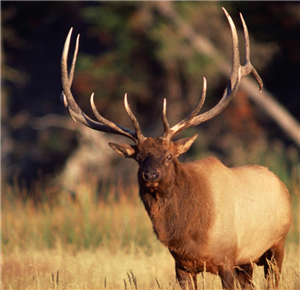
by John Paul Morris
A gunshot on September 1st, 1877 silenced the bugling of the last Eastern elk in the world, and the United States Fish and Wildlife Service declared the sub-species extinct in 1880. The Eastern elk was larger than the Rocky Mountain variety: bulls could weigh 1,000 pounds, stand over five feet at the shoulder, and carry racks more than six feet in overall length. Unregulated market hunting by both the new European settlers and the newly-armed Native Americans had taken its toll. 
Today, in an effort to redress this wrong and return the elk to the vast hardwoods of our eastern states and parts of Canada, the Rocky Mountain Elk Foundation® has implemented programs to restore elk (though of the Rocky Mountain sub-species) in Wisconsin, Ontario, Kentucky, Tennessee, the Great Smoky Mountains National Park, Missouri, and Virginia.
Actually hunting for elk in these newly-repopulated Midwestern and eastern states varies by region, as each restoration project is in a different phase. Kentucky has one of the most populous and healthy herds in the east, with approximately 10,000 animals in the herd, a 92% breeding success rate, and a 90% calf survival rate. And not only is the Kentucky herd thriving, but individual elk average 15% larger than their Western relations, due to milder winters, plentiful food, and lack of natural predators. Recently, I was lucky enough to join the Kentucky Department of Fish and Wildlife Resources and dart an impressive bull so that it could be tagged and tracked. It was quite an experience, being so close to one of these beautiful animals.
Anyone can apply for a Kentucky elk tag, in one or more of four categories: bull archery, bull firearm, cow archery, or cow firearm. 765 elk were taken in the 2011 season, and the herd continues to grow. Hunters enjoy a high success rate: in 2012, 89% of Bull Firearms hunters took and elk, and 76% of archery hunters took bulls. Kentucky's effort to contain the elk to the 15-county restoration zone includes allowing anyone with a regular deer tag to take elk that wander out of the zone. Along with the carefully calculated harvest inside the zone, these policies help restrict the herd to a defined area where they can thrive.
By contrast, the Missouri elk restoration project is still in its beginning stages—an original release of 34 elk, sourced from the highly successful Kentucky herd, was released in June of 2011, and natural breeding and a few supplemental releases have increased the herd size to over 106 as of the summer of 2013. Lonnie Hansen, of the Missouri Department of Conservation says that there are likely calves born this year that haven't been seen yet, hopefully increasing the herd size even more. As to when the first elk hunt in a century and a half will take place in Missouri, he approximates that around 2016, or when the herd reaches approximately 200 individuals, very limited tags may be issued.
Through the efforts of Rocky Mountain Elk Foundation and the hard work of the various state wildlife agencies, elk are finally roaming their ancestral lands of the American east once again—presenting ever improving opportunities for hunting and viewing these magnificent creatures. So the next time you're hiking the Appalachian Trail, or sitting on a deer stand in the Ozarks, listen for that haunting bugle piercing the morning stillness.
- 5972 views

